Abstract
The daily intake of FA of 5% Americans age 50 and over and in one study of psoriatic American women is about 1 mg. A patient with plaque psoriasis on 10 mg lisinopril did not improve on vitamins B12 and B6 alone. When folic acid 5 mg daily was added PASI improved 50%. Three cases of plaque psoriasis flared when given 1-2 mg folic acid (FA), 100 mg vitamin B6 and 1000 mcg daily B12. When daily FA was increased to 4 to 7 mg daily all three cases improved their disease.
Introduction
Homocysteine (Hcy) affects neutrophil activity increasing superoxide release, IL-8 mRNA and growth related oncogene alpha causing reduction in spontaneous neutrophil apoptosis [1]. Hcy also increases intracellular H2O2 production by neutrophils and neutrophil migration [2,3]. Hcy reduces endothelial nitric oxide synthase causing endothelial dysfunction [4,5]. Five mg Folic acid week 1 followed by 1 mg for the next 3 weeks given to patients with plasma Hcy over 15 umol/L reduces chemokines from mononuclear cells [6]. Plasma Hcy correlates directly and FA levels inversely with psoriasis area and severity index (PASI) [7]. Plasma folic acid levels inversely correlate with PASI [8].
Homocysteine can be lowered by 1mg folic acid 500 mcg vitamin B12 and as little as 10 mg daily vitamin B6 over a 12-week period [9]. Other studies however use vitamin B6 at 100 mg daily [10].
A past study showed no benefit treating psoriasis with 6 weeks of twice daily FA 5 milligrams (mg) and 1-2000 micrograms (mcg) B12 [7]. We, however, have published case reports where FA (5-6 mg daily) with vitamins B6 (100 mg daily) and B12 (1000 mcg daily) improves psoriasis in two alcoholics and clears palmar plantar pustulosis, a disorder genetically related to some psoriasis through the CARD14 gene [11,12]. CARD14 mutations are associated with palmar plantar psoriasis through activation usually of NF-Kappa B. CARD 14 is found on epidermal keratinocytes as well as dermal cells [13,14]. Anti-inflammatory doses of folic acid reduce NF-kappaB [15].
In our study where 12 weeks of United States Pharmacopeia (USP) approved or NSF International certified [16,17] of daily 5mg FA, B6 and B12 were added to patients already on 16 weeks of adalimumab 4 of 7 subjects continued to improve, but 2 of 7 patients’ psoriasis worsened, and 1 did not change. Both patients who worsened initially has very high serum vascular endothelial nitric oxide synthase levels [18].
I present one psoriasis patient on lisinopril 10 mg daily who did not respond to vitamins B12 and B12 but who was improved when folic acid was added. Three psoriasis patients are then presented with elevated homocysteine who flared on FA 1-2 mg daily. These three subsequently improved with daily folic acid 4-7 mg, plus vitamin B12 1000 mcg and vitamin B6 100 mg.
Case reports
Case 1
Self-experimentation can lead to biased interpretations [19], but when good and ill comes from such experience, bias should be balanced if not minimized.
A 55-year-old man weighed 87 kilograms (kg) and had stage 3 chronic kidney disease. His psoriasis appeared initially at age 23. It had not been controlled using clobetasol ointment and calcipotriene cream (Figure 1). Fasting plasma homocysteine was 15.8 micromoles per liter (umol/L) (normal 4-14umol/L). Lowering homocysteine was thought possible with at least 0.8 mg of FA plus B6 and B12 [21]. Four weeks of daily USP FA 1-2 mg, 100 mg B6 plus 100 mcg B12 led to elevation of Hcy to 16.2 and PASI 7.6, increasing to 16.9 and PASI 11.3 between weeks 4 and 9 (Figure 2).
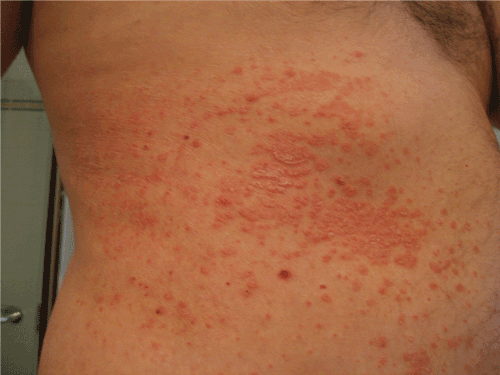
Figure 1. Patient 1 prior to folic acid, vitamin B6 and Vitamin B12.
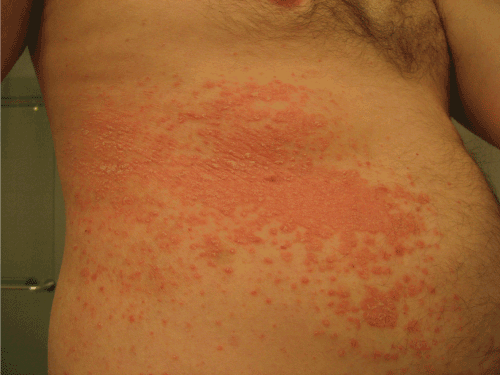
Figure 2. Patient 1 after week 4 folic acid 1-2 mg, B6 and B12.
Five mg FA was later discovered to be needed to lower hyperhomocysteinemia in patients with predialysis chronic renal failure [21]. Oral FA was increased from 5 then to 7-8 mg with B6 100 mg, B12 1000 mcg daily and, for 2 weeks, resveratrol at 10-37.5 mg or 4 ounces red muscadine ‘wine’ daily (oral resveratrol has since been discredited as a treatment) [22,23]. PASI reduction reached 78% by week 10 of this regimen (Figure 3). Hcy fell to 13.5 umol/L.
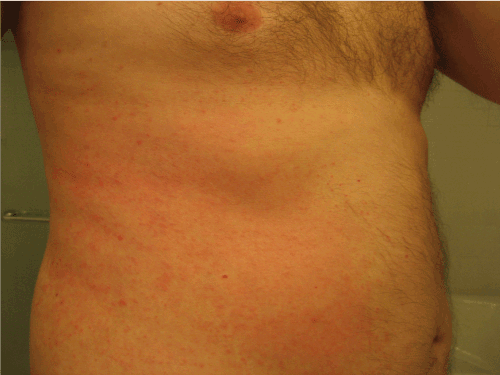
Figure 3. Patient 1 week 10 folic acid 5-8 mg FA, vitamin B6 and B12.
He went off vitamins, suffered inferior wall myocardial infarction 14 weeks later and then coronary artery syndrome the latter repaired using a triple coronary artery bypass.
The 3 B were restarted (FA 5 mg daily) for Hcy which by then had reached 18 umol/L. Seven and a half months later while on the drug carvedilol 3.125 mg twice daily, pits were only noted at the far end of fingernails and were gone one month later (Figures 4 and 5). He flared slightly when lisinopril 2.5 mg daily was added. Control was regained when folic acid dose was increased to 7 mg daily and then maintained at 6 mg daily (Figures 6 and 7).
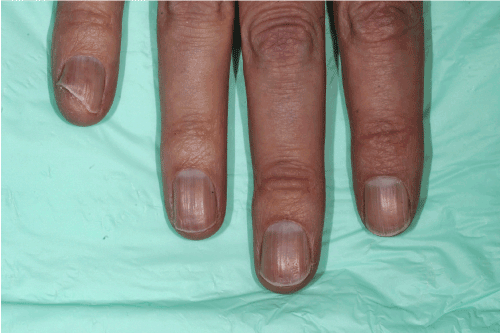
Figure 4. Nails 6 ½ months on FA 5mg. B6 and B12.
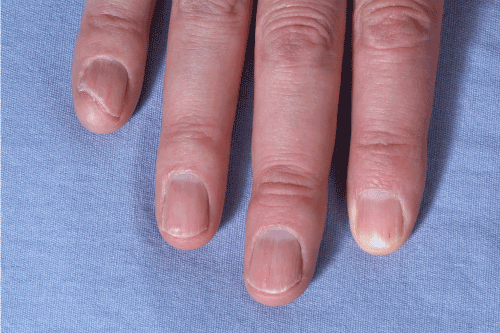
Figure 5. Nails 7 ½ months on FA 5 mg, B6 and B12.
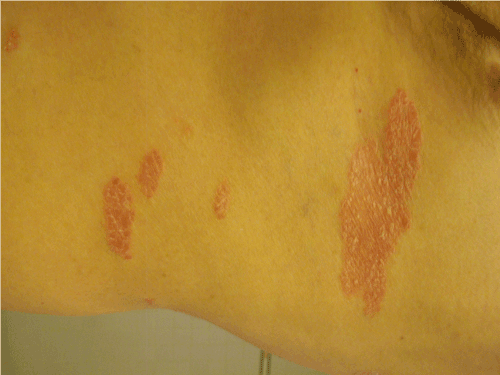
Figure 6. After 1isinopril 2.5 mg on 5 mg FA, B6 and B12.
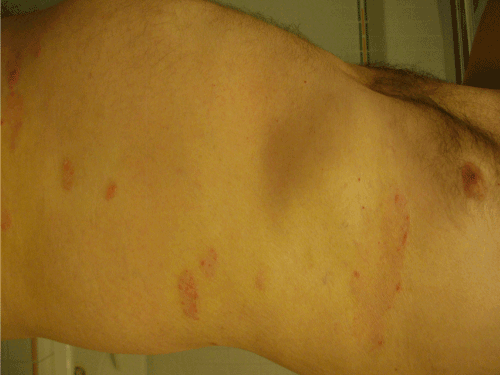
Figure 7. After Lisinopril 2.5 mg on 7 mg FA,B6 and B12.
Case 2
81-year-old 90 kg. white male with psoriasis has a history of malignant melanoma in situ, other skin cancers and a cardiac stent. His homocysteine was slightly elevated (12.1 umol/L). He was on Lisinopril 10 mg daily. He had no response to topical medications alone. During the subsequent 8-week period and still on 10 mg. daily Lisinopril adding folic acid 5 mg to vitamin B12 and vitamin B6l resulted in week 3 BSA 7.7% falling to week 11 BSA 4.5% with improvement in lesion thickness and scale (PASI 50) (Figures 8 and 9). This response was not noticed by the patient except that his itching was reduced.
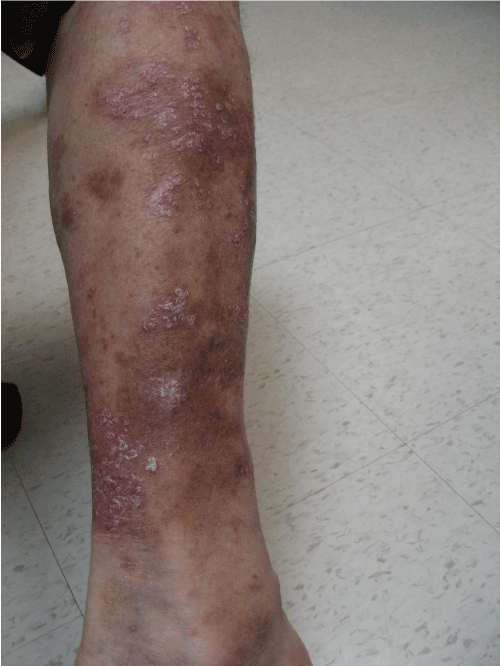
Figure 8. Patient 2. Before vitamins.
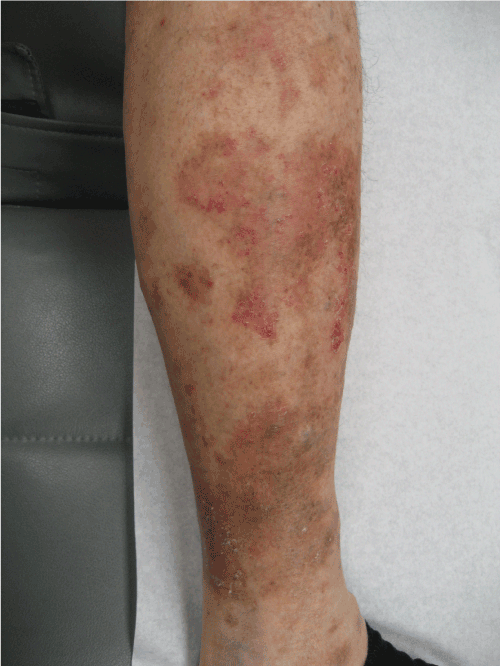
Figure 9. Patient 2 on vitamins.
Case 3
A 40-year-old 60 kg man had psoriasis was on maintenance phototherapy with over 18 treatments of narrow band ultraviolet B phototherapy (nb-UVB) and calcipotriene 0.005% -betamethasone dipropionate 0.064% ointment. Hcy was 15.1 umol/L (normal 4 to 14 umol/L). His body surface area (BSA) involvement was 1.5 percent (%). Still on nb-UVB, he was told to take the 3 B vitamins but he took 1 mg FA daily plus B6 (100 mg) And B12 (1000 mcg). His psoriasis flared 10 weeks later (5% BSA).
Over the next 6 weeks on 4 mg FA his BSA improved 22%.
Case 4
This man was 56 years old, weighed 104 kg, and was 67 inches tall. He had diffuse plaque psoriasis despite a trial of NB-UVB and then alefacept. On week 13 of alefacept with Hcy 17 umol/L (normal 4-14 umol/L ).he was begun on daily FA 1 mg, B6 (100 mg) and B12 (1000 mcg). He was also on calcipotriene 0.005% - betamethasone dipropionate 0.064% ointment and tacrolimus 0.1% ointment. After 16 weeks of alefacept, his BSA was still 15-20%. Seven weeks off alefacept but still on the 3 B vitamins, his BSA was 28%.
Etanercept 50 mg twice weekly was begun with daily FA 1 mg, B6 and B12 added. Four months later his psoriasis BSA was`4.8%. He required aspirin 325 mg three times daily for joint pain. Ten months after starting etanercept and aspirin and still on 50 mg once weekly and for the next year he had 1% BSA involved. His weight had increased to 250 pounds. Six months later his joint pain worsened and his psoriasis has increased to 3% BSA. Shortly thereafter had a respiratory infection with etanercept held for 1 month, restarted one month later and then held for 3 months. When etanercept was again started, topical clobetasol ointment was also started. His legs and buttocks had larger plaques with scattered trunk and arm plaques as well. His weight was 247 pounds. When seen two months later Ibuprofen 800 mg daily to twice daily had been added along with colchicine 0.6 mg bid for joint pain rethought as secondary to gout. FA had been increased to 2000 mcg daily. BSA had increased to 9% BSA. Three weeks later while ibuprofen and colchicine were continued, his FA was increased to 5 mg daily. Twenty weeks later his psoriasis had almost cleared (BSA 0.1%) (Figure 10).
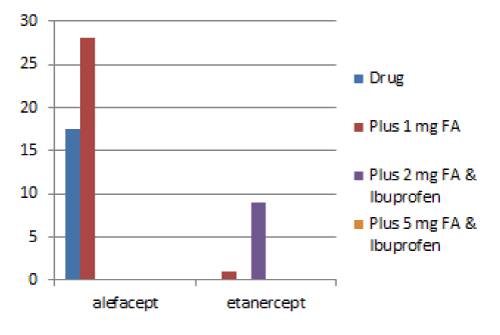
Figure 10. Patient 4 BSA on alefacept and then on etanercept.
Comment
Regulatory T (TReg) cells expressing the transcription factor forkhead box P3 (Foxp3+ cells) are naturally present in the immune system. They are indispensable for the maintenance of dominant self-tolerance and immune homeostasis [24]. CD4+central memory T cells can differentiate into Foxp3+ T cells [25]. Folate receptors lie on memory T cells in Psoriasis [26]. Thus folic acid may promote the activity of the body’s own method of controlling excessive inflammation.
In a study FA was incubated over endothelial cells in 0.5 and in 5 umol. The endothelial nitric oxide synthase dimer to monomer ratio increased from 1.5 to 1 in controls, about 1.7 to one using 0.5 umol FA and to about 2.25 to one using 5 umol [27]. In this same article was a report on eighty-four patients with coronary artery disease received either 400 mcg or 5 mg folic acid daily for a 6-week treatment period. Both 400 mcg/day and 5 mg /day FA significantly increased plasma folate and decreased plasma Hcy 5mg/day - but not 400 mcg/day folic acid improves blood vessel cell function in coronary artery disease patients as measured by flow mediated dilatation [27]. Thus higher dimeric (conjugated) to monomeric eNOS ratios have anti-inflammatory properties not seen with lower folic acid.
Failure of high dose (10 mg daily) FA plus weekly 1-2000 mcg B12 in affecting psoriasis in a past study by others [10] was performed in the United Kingdom. There, FA dosing has been found to be frequently inaccurate, mostly too low [28]. We, however, also used vitamin B6. Inducible nitric oxide synthase (iNOS) is a psoriasis susceptibility locus [29].
Etanercept-cleared psoriasis skin has 87% less iNOS [30] Supplemental vitamin B6 also lowers iNOS [31]. Messenger RNA expression of iNOS is increased in psoriasis [32]. Psoriasis models show increased vascular production of peroxynitrite accompanied by increased expression of the iNOS and nicotinamide dinucleotide phosphate (NADPH) oxidase [33]. Peroxynitrite oxidizes the essential NOS cofactor (6R-5,6,7,8-tetrahydrobiopterin (BH4). Consequently, oxygen reduction uncouples from NO synthesis, transforming NOS into a proinflammatory superoxide enzyme [34]. BH4 supplementation converts endothelial NOS (eNOS) back to producing anti-inflammatory NO [34].
Relevant to the above cases, High dose FA can improve BH4 recycling due to restoration of dihdrofolate reductase expression [35]. High dose FA also helps de-activate peroxynitrite-derived radicals [36,37].
One to two mg daily folic acid appears be pro-inflammatory for psoriasis. With a possible mean loss in folate levels of up to 27% while Patient 3 was on nb-UVB over 18 treatments [38], This patient‘s psoriasis flared on 1 mg daily folic acid but cleared slightly when given 4 mg a day.
Recommended daily allowances for folate in adults are 400 mg dietary folate equivalents DFEs) for adult men and women unless the woman is lactating (when it is 500 mg DFE) or pregnant (600 mg DFEs). Americans 50 and older unnecessarily have the highest total folate intake. Five percent of this population has intakes exceeding the UL of 1,000 mcg per day. This is thought mainly due to folic acid from dietary supplements [40]. One thousand mcg daily is thought excessive because some but not all literature suggests that high dose folic acid increases colon and prostate cancer risk [39]. However, a recent study suggests 600 mg a day of folic acid reduces DNA biomarkers of cancer adjacent to colon polyp sites [40]. After multivariate adjustment, a recently published study in female US nurses showed a non-statistically significant increased risk of psoriasis to the subgroup having low dietary folate equivalent (DFE) intake among those drinking over 5 nonlight beers per week as compared to the high DFE group in this study. The median intake was 976 ug in this study from 1991-2002 and 1000 ug in the 2003-2006 period [41]. Both groups however include DFEs at or near the 1000-2000 ug daily dose range where folate in our cases seems to flare psoriasis.
Vascular endothelial growth factor (VEGF) is elevated in models of psoriasis [42]. Patients with severe psoriasis and those with onset of psoriasis between the ages of 20 and 40 are thought to have elevated plasma levels of VEGF, VEGF alleles and VEGF receptors [42]. In our study where 5 mg FA, 100 mg B6 and 1000 mcg B12 daily was added to adalimumab for 16 weeks [18], Adalimumab alone caused all study patients to lower their VEGF. The addition of the B vitamins caused mild rise in VEGF. Two of three patients with high baseline VEGF (147 and 259 pg/ml) and who had BMIs of 23 and 24.9 (and thus less leptin to stabilize the anti-inflammatory activities of coupled eNOS) flared their psoriasis when 5 mg FA, B6 and B12 were added. One of these patients also developed H. pylori antibodies which may have prevented full ingestion of the B vitamins causing the dosing to possibly promote uncoupled eNOS [43]. One patient in this same study had his Hcy increase while on the B vitamins and despite his high initial VEGF his psoriasis continued to improve on adalimumab [12]. In vitro Hcy reduces expression of VEGF-A and VEGFR [44]. Reducing Hcy with 1-2 mg daily FA may have also promoted psoriasis by allowing VEGF effect to increase in patients 1 and 3.
Patient 3 improved 22% on 4 mg FA, B6 and B12. The 4-mg dose lowered additionally by NB-UVB seems too low a dose for much improvement despite the NB-UVB also lowering his VEGF [45]. Since he was 40 years old when he flared and his BMI was low, the risk of having elevated VEGF was high [43] possibly making him a poorer candidate for the effects of a high FA dose.
Neutrophil activity was enhanced by rising Hcy in patient 1 when given low FA. When lisinopril was added VEGF effect may have reasserted its effects.
Patient 2’s PASI only cleared 50%. He was on 10 mg daily lisinopril; Patient 1 flared when lisinopril 2.5 mg daily was added being already on low dose carvedilol but improved again when folic acid was increased from 5 to 7 mg daily. Patient 4 flared when ibuprofen was added despite being on etanercept. Patient 4 nearly cleared on etanercept when 1 mg FA was increased to 5 mg FA without stopping the ibuprofen. Ibuprofen and third generation beta blockers like carvedilol preserve or promote NOS or VEGF or Both [46-48]. Theoretically depending on which type of NOS is preserve these drugs could improve or worsen psoriasis. Homocysteine is lowered by ACE inhibitors and betas blockers which by itself should improve psoriasis [49]. A case control study did not associate beta blocker use with psoriasis flare [501]. However, a case control study however did associate psoriasis flares to ACE inhibitor and non-steroidal anti-inflammatory drug ingestion [51]. How ACE inhibitors flare psoriasis is not known unknown Wilkin et al., followed by Coulter suggested that ACE- inhibitors not only inhibit angiotensin II production, but also inhibit kinin catabolism. Thus ACE- inhibitors potentiate the activity of kinins and thus may cause exacerbation of kinin-associated skin disorders [52]. Possibly relevant to case 4 is that at least in mice, ibuprofen doses of 1.0 mg/kg or more raise VEGF levels [53].
Relevant to future cases would be attempts to treat patients the methyltetrahydrofolate reductase deficiency and mutations. Conversion of homocysteine to another amino acid methionine requires Methylenetetrahydrofolate reductase. This enzyme converts a molecule called 5,10-methylenetetrahydrofolate to a molecule called 5-methyltetrahydrofolate [54].
Patients with severe MTHFR deficiency have elevated homocysteine and low blood methionine and variably preset in childhood or at older ages with neurological and vascular abnormalities. A milder MTHFR deficiency, is associated with a thermolabile enzyme, may increase susceptibility for cardiovascular disease and for neural tube defects [55].
Methyltetrahydrofolate reductase has two common mutations. For example, Incidence of MTHFR 677T mutations are between 10 and 36% of the population [56]. The 677C or 677T mutation patients commonly show elevated total Hcy and low plasma folate. A high oral dose of folic acid can between 23% and 40% of patients depending on specific genotype reduce tHcy [57]. Additional causes of reduced homocysteine metabolism are the A1298C MTHFR mutations [58]. Homocysteine is elevated in alcoholics. Moderate alcohol intake and low MTHFR activity, and the MTHFR677 genotype, (but not he MTHFR1298 genotype) have adverse effects on tHcy, but those effects may be overcome by sufficient folate intake [59,60]. High dose folic acid appears to be a treatment for at least some patients who need folic acid who have MTHFR mutations [61,62].
Conclusions
Daily FA 1-2 mg can flare psoriasis. This doe is common in the US population over 50 and in the psoriasis population.
Four or more mg daily FA appears to variably improve psoriasis in these same patients. Reducing or stopping FA 4-8 mg daily may place a patient at risk for comorbid events due to the passage through FA levels that would promote pro-inflammatory side effects. The safety of stopping and the safety of continuing this therapy requires study.
Acknowledgements
The author is investigator in a study quoted in the manuscript that was funded by Abbott and ABBVIE (Aronson PJ, Swearingen J, Malick F, Mehregan DA, and Mehregan DM. High dose folic acid, plus vitamins B6 and B12 added to Adalimumab can worsen psoriasis in patients with low BMIs and in others may cause unanticipated EKG effects. J Dermatolog Clin Res. 2015 Jan 3(1): 1039 http://www.jscimedcentral.com/Dermatology/) and part of one case was part of the Observe -5 study by Amgen on etanercept which we have received permission to separately report.
References
- Glynn PC, Henney E, Hall IP (2002) The selective CXCR@ antagonist SB272844 blocks interleukin-8 and growth-related oncogene-alpha-mediated inhibition of spontaneous neutrophil apoptosis. Pulm Pharmacol Ther 15: 103-110. [Crossref]
- Ubagai T, Tansho S, Ito T, Ono Y (2008) Influences of aflatoxin B(1) on reactive oxygen species generation and chemotaxis of human polymorphonuclear leukocytes. Toxicol In Vitro 22: 1115-11120. [Crossref]
- Fuhler GM, Knol GJ, Drayer AL, Vellenga E (2005) Impaired interleukin-8- and GROalpha-induced phosphorylation of extracellular signal-regulated kinase result in decreased migration of neutrophils from patients with myelodysplasia. J Leukoc Biol 77: 7. [Crossref]
- Bechara C, Wang X, Chai H, Lin PH, Yao Q, et al. (2007) Growth-related oncogene-alpha induces endothelial dysfunction through oxidative stress and downregulation of eNOS in porcine coronary arteries. Am J Physiol Heart Circ Physiol 293: H3088-H3095. [Crossref]
- Alvarez-Maqueda M, El Bekay R, Monteseirín J, Alba G, Chacón P, et al. (2004) Atherosclerosis Homocysteine enhances superoxide anion release and NADPH oxidase assembly by human neutrophils. Effects on MAPK activation and neutrophil migration. Atherosclerosis 172: 229-386. [Crossref]
- Holven KB, Aukrust P, Holm T, Ose L, Nenseter MS (2002) Folic acid treatment reduces chemokine release from peripheral blood mononuclear cells in hyperhomocysteinemic subjects. Arterioscler Thromb Vasc Biol 22: 699-703. [Crossref]
- Malherba M, Gisondi P, Radaeli A, Sala R, Calzavara Pinton PG, et al. (2006) Plasma homocysteine and folate levels in patient with chronic plaque psoriasis. Br J Dermatol 155: 1165-1169. [Crossref]
- Cakmak SK1, Gül U, Kiliç C, Gönül M, Soylu S, et al. (2009) Homocysteine, vitamin B12 and folic acid levels in psoriasis patients. J Eur Acad Dermatol Venereol 23: 300-303. [Crossref]
- Ubbink JB, van der Merwe A, Vermaak WJ, Delport R (1993) Hyperhomocysteinemia and the response to vitamin supplementation. Clin Investig 71: 993-998. [Crossref]
- Dawson TA, Scott KW, Merrett JD (1978) Trial of folic acid therapy in psoriasis. Ulster Med J 47: 100-101. [Crossref]
- Aronson PJ, Malick F (2010) Towards rational treatment of severe psoriasis in alcoholics: report of two cases. J Drugs Dermatol 9: 405-408. [Crossref]
- Aronson PJ, Zhang J (2016) Palmar plantar pustulosis responding to high-dose folic acid plus vitamins B6 and B12. JAAD Case Rep 2: 19-21. [Crossref]
- Feng D1, Zhou Y, Xia M, Ma J (2011) Folic acid inhibits lipopolysaccharide-induced inflammatory response in RAW264.7 macrophages by suppressing MAPKs and NF-?B activation. Inflamm Res 60: 817-822. [Crossref]
- Mössner R, Frambach Y, Wilsmann-Theis D, Löhr S, Jacobi A, et al. (2015) Palmoplantar Pustular Psoriasis Is Associated with Missense Variants in CARD14, but Not with Loss-of-Function Mutations in IL36RN in European Patients. J Invest Dermatol 135: 2538-2541. [Crossref]
- Jordan CT, Cao L, Roberson ED, Duan S, Helms CA, et al. (2012) Rare and common Variants in CARD14, encoding an epidermal regulator of NF-kappa B, in psoriasis. Am J Hum Genetics 90: 796-808. [Crossref]
- http://www.nist.gov/standardsgov/upload/USP.pdf (accessed 3/12/2016)
- http://www.nsf.org/about-nsf/nsf-mark (accessed April 24,2016)
- Aronson PJ, Swearingen J, Malick F, Mehregan DA, Mehregan DM (2015) High dose folic acid, plus vitamins B6 and B12 added to Adalimumab can worsen psoriasis in patients with low BMIs and in others may cause unanticipated EKG effects. J Dermatolog Clin Res 3: 1039.
- www.news.harvard.edu/gazette/2004/04.29/11-selfexperiment.html (accessed 3/12/2016).
- Clarke R, Lewington S, Sherliker P, Armitage J (2007) Effects of B-vitamins on plasma homocysteine concentrations and on risk of cardiovascular disease and dementia. Curr Opin Clin Nutr Metab Care 10: 32-39.
- Thambyrajah J, Landray MJ, McGlynn FJ, Jones HJ, Wheeler DC, et al. (2000) Does folic acid decrease plasma homocysteine and improve endothelial function in patients with predialysis renal failure? Circulation 102: 871-875. [Crossref]
- Schroecksnadel K, W2021 Copyright OAT. All rights reservWeiss G, et al. (2005) Anti-inflammatory compound resveratrol suppresses homocysteine formation in stimulated human peripheral blood mononuclear cells in vitro. Clin Chem Lab Med 43: 1084-1088. [Crossref]
- Farris P, Krutmann J, Li YH, McDaniel D, Krol Y (2013) Resveratrol: a unique antioxidant offering a multi-mechanistic approach for treating aging skin. J Drugs Dermatol 12: 1389-1394. [Crossref]
- Sakaguchi S, Miyara M, Costantino CM, David A. Hafler DA (2010)FOXP3+ regulatory T cells in the human immune system. Nat Rev Immunol 10: 490-500. [Crossref]
- Zhang X , Li XC, Xiao X, Sun R, Tian Z, et al. (2013) CD4+CD62L+ Central Memory T Cells Can Be Converted to Foxp3+ T Cells. PLoS One 8: e77322. [Crossref]
- Walker LS1 (2007) Regulatory T cells: Folate receptor 4: a new handle on regulation and memory? Immunol Cell Biol 85: 506-507. [Crossref]
- Moat SJ1, Madhavan A, Taylor SY, Payne N, Allen RH, et al. (2006) High- but not low-dose folic acid improves endothelial function in coronary artery disease. Eur J Clin Invest 36: 850-859. [Crossref]
- Sculthorpe NF, Davies B, Ashton T, Allison S, McGuire DN, et al. (2001) Commercially available folic acid supplements and their compliance with the British Pharmacopoeia test for dissolution. J Public Health Med 23: 195-197. [Crossref]
- Suarez-Farinas M, Fuentes-Duculan J, Lowes MA, Krueger JG (2011) Resolved psoriasis lesions retain expression of a subset of disease-related genes. J Invest Dermatol 131: 391-400. [Crossref]
- Stuart PE, Nair RP, Ellinghaus E, Ding J, Tejasvi T, et al. (2010) Genome-wide association analysis identifies three psoriasis susceptibility loci. Nat Genet 42: 1000-1004. [Crossref]
- Komatsu S1, Yanaka N, Matsubara K, Kato N (2003) Antitumor effect of vitamin B6 and its mechanisms. Biochim Biophys Acta 1647: 127-130. [Crossref]
- Sirsjö A, Karlsson M, Gidlöf A, Rollman O, Törmä H (1996) Increased expression of inducible nitric oxide synthase in psoriatic skin and cytokine-stimulated cultured keratinocytes. Br J Dermatol 134: 643-648. [Crossref]
- Karbach S, Croxford AL, Oelze M, et al. (2014) Interleukin 17 drives vascular inflammation, endothelial dysfunction, and arterial hypertension in psoriasis-like skin disease. Arterioscler Thromb Vasc Biol 34: 2658-2668. [Crossref]
- Schmidt TS, Alp NJ (2007) Mechanisms for the role of tetrahydrobiopterin in endothelial function and vascular disease. Clin Sci (Lond) 113: 47-63. [Crossref]
- Förstermann U (2006) Janus-faced role of endothelial NO synthase in vascular disease: uncoupling of oxygen reduction from NO synthesis and its pharmacological reversal. Biol Chem 387: 1521-1533. [Crossref]
- Chalupsky K, Kracun D, Kanchev I, Bertram K, Görlach A (2015) Folic Acid Promotes Recycling of Tetrahydrobiopterin and Protects Against Hypoxia-Induced Pulmonary Hypertension by Recoupling Endothelial Nitric Oxide Synthase. Antioxid Redox Signal 23: 1076-1091. [Crossref]
- McCarty MF, Barroso-Aranda J, Contreras F (2009) High-dose folate and dietary purines promote scavenging of peroxynitrite-derived radicals-clinical potential in inflammatory disorders. Med Hypotheses 73: 824-834. [Crossref]
- El-Saie LT1, Rabie AR, Kamel MI, Seddeik AK, Elsaie ML (2011) Effect of narrowband ultraviolet B phototherapy on serum folic acid levels in patients with psoriasis. Lasers Med Sci 26: 481-485. [Crossref]
- https://ods.od.nih.gov/factsheets/Folate-HealthProfessional/ (accessed May 24, 2017)
- O'Reilly SL, McGlynn AP, McNulty H, Reynolds J, Wasson GR, et al. (2016) Folic Acid Supplementation in Postpolypectomy Patients in a Randomized Controlled Trial Increases Tissue Folate Concentrations and Reduces Aberrant DNA Biomarkers in Colonic Tissues Adjacent to the Former Polyp Site. J Nutr 146: 933-939. [Crossref]
- Qureshi AA1, Dominguez PL, Choi HK, Han J, Curhan G (2010) Alcohol intake and risk of incident psoriasis in US women: a prospective study. Arch Dermatol 146: 1364-1369. [Crossref]
- Canavese M, Altruda F, Ruzicka T, Schauber J (2010) Vascular endothelial growth factor (VEGF) in the pathogenesis of psoriasis--a possible target for novel therapies? J Dermatol Sci 58: 171-176. [Crossref]
- Young HS, Summers AM, Bhushan M, Brenchley PE, Griffiths CE (2004) Single-nucleotide polymorphisms of vascular endothelial growth factor in psoriasis of early onset. J Invest Dermatol 122: 209-215. [Crossref]
- Chen HQ, Li X, Tang R (2015) Effects of Narrow Band Ultraviolet B on Serum Levels of Vascular Endothelial Growth Factor and Interleukin-8 in Patients with Psoriasis. Am J Ther 23: e655-e662. [Crossref]
- Zhang Q, Li Q, Chen Y, Huang X, Yang IH, et al. (2012) Homocysteine-impaired angiogenesis is associated with VEGF/VEGFR inhibition. Front Biosci (Elite Ed) 4: 2525-2535. [Crossref]
- de Boer RA, Siebelink HJ, Tio RA, Boomsma F, van Veldhuisen DJ (2001) Carvedilol increases plasma vascular endothelial growth factor (VEGF) in patients with chronic heart failure. Eur J Heart Fail 3: 331-333. [Crossref]
- Vanhoutte PM1, Gao Y (2013) Beta blockers, nitric oxide, and cardiovascular disease. Curr Opin Pharmacol 13: 265-273. [Crossref]
- Li W, Xu RJ, Lin ZY, Zhuo GC, Zhang HH (2009) Effects of a cyclooxygenase-1-selective inhibitor in a mouse model of ovarian cancer, administered alone or in combination with ibuprofen, a nonselective cyclooxygenase inhibitor. Med Oncol 26: 170-177. [Crossref]
- Poduri A, Kaur J, Thakur JS, Kumari S, Jain S, et al. (2008) Effect of ACE inhibitors and ß-blockers on homocysteine levels in essential hypertension. J Hum Hypertens 22: 289–294. [Crossref]
- Brauchli YB, Jick SS, Curtin F, Meier CR (2008) Association Between Beta-Blockers, Other Antihypertensive Drugs and Psoriasis: Population-based Case-control Study. The Br J Dermatol 158: 1299-1300. [Crossref]
- Cohen AD, Bonneh DY, Reuveni H, Vardy DA, Naggan L, et al. (2005) Drug exposure and psoriasis vulgaris: case-control and case-crossover studies. Acta Derm Venereol 85: 299-303. [Crossref]
- www.lareb.nl/Signalen/Signals_2015_ACE_inhibitors_psoriasis.aspx (accessed May 28,2017).
- Beharry KD1, Modanlou HD, Hasan J, Gharraee Z, Abad-Santos P, et al. (2006) Comparative effects of early postnatal ibuprofen and indomethacin on VEGF, IGF-I, and GH during rat ocular development. Invest Ophthalmol Vis Sci 47: 3036-3043. [Crossref]
- https://ghr.nlm.nih.gov/gene/MTHFR (accessed May21, 2017).
- Goyette P1, Christensen B, Rosenblatt DS, Rozen R (1996) Severe and mild mutations in cis for the methylenetetrahydrofolate reductase (MTHFR) gene, and description of five novel mutations in MTHFR. Am J Hum Genet 59: 1268-1275. [Crossref]
- Isotalo PA, Wells GA, Donnelly JG (2000) Neonatal and fetal methylenetetrahydrofolate reductase genetic polymorphisms: an examination of C677T and A1298C mutations. Am J Hum Genet 67: 986-990. [Crossref]
- Liu CS, Chiang HC, Chen HW (2004) Methylenetetrahydrofolate reductase polymorphism determines the plasma homocysteine-lowering effect of large-dose folic acid supplementation in patients with cardiovascular disease. Nutrition 20: 974-978. [Crossref]
- Pawlak AL, Strauss E (2001) Polymorphism of the methylenetetrahydrofolate reductase gene (MTHFR) and incidence of hyperhomocysteinemia-related diseases. Postepy Hig Med Dosw 55: 233-256. [Crossref]
- Chiuve SE, Giovannucci EL, Hankinson SE, Hunter DJ, Stampfer MJ, et al. (2005) Alcohol intake and methylenetetrahydrofolate reductase polymorphism modify the relation of folate intake to plasma homocysteine. Am J Clin Nutr 82: 155-162. [Crossref]
- http://pubs.niaaa.nih.gov/publications/arcr351/25-35.htm (Accessed July 25,2016.)
- Lynn B. Bailey LR, Gregory JFIII (1999) Polymorphisms of Methylenetetrahydrofolate Reductase and Other Enzymes: Metabolic Significance, Risks and Impact on Folate Requirement. J Nutr 129: 919-922. [Crossref]
- Weisberg I, Pamela Tran P, Christensen B, Sibani S, Rima Rozen (1998) Second Genetic Polymorphism in Methylenetetrahydrofolate Reductase (MTHFR) Associated with Decreased Enzyme Activity. Metabolism. Mol Genet Metab 64: 169-172. [Crossref]










